Why is sustainability significant?
As we realise the impact of our actions on the environment and future generations, sustainability has emerged as a paramount issue in today's world. Our planet faces complex and interconnected challenges such as resource depletion, biodiversity loss, and environmental degradation. By adopting sustainable practices and taking action at both individual and collective levels, we can work towards a better tomorrow.

Working bee on a canola field flower.
What is sustainability?
Sustainability refers to the ability to meet the needs of the present generation without compromising the ability of future generations to meet their own needs. In other words, it involves finding a balance between economic, social, and environmental factors to ensure that resources are used in a way that is not only environmentally responsible but also socially equitable and economically viable in the long term.
Read more: Sustainability simplified: Carbon footprinting for beginners
The importance of sustainability for a better tomorrow
Sustainability is vital for creating a better future because it tackles the challenges we face comprehensively. Environmental protection is a vital component of sustainability. It addresses the preservation of the natural resources and ecosystems that support life on our planet. However, sustainability doesn’t only refer to protecting the environment—it also focuses on promoting social equity and economic viability.
Read more: Sustainability simplified II: Carbon units for beginners
By creating a fairer and more just society and adopting sustainable business practices, we can create economic opportunities that benefit both the planet and our communities. Moreover, by adopting sustainable practices today, we can future-proof our societies and economies against likely future challenges. This is why sustainability provides a comprehensive framework for creating a resilient, equitable, and prosperous world that benefits everyone, both now and in the future.
Read more: 5 Sustainable business practices to achieve net zero
Green Earth recognises the significance of integrating sustainability in all aspects of our lives to ensure balance for both human activity and the environment.
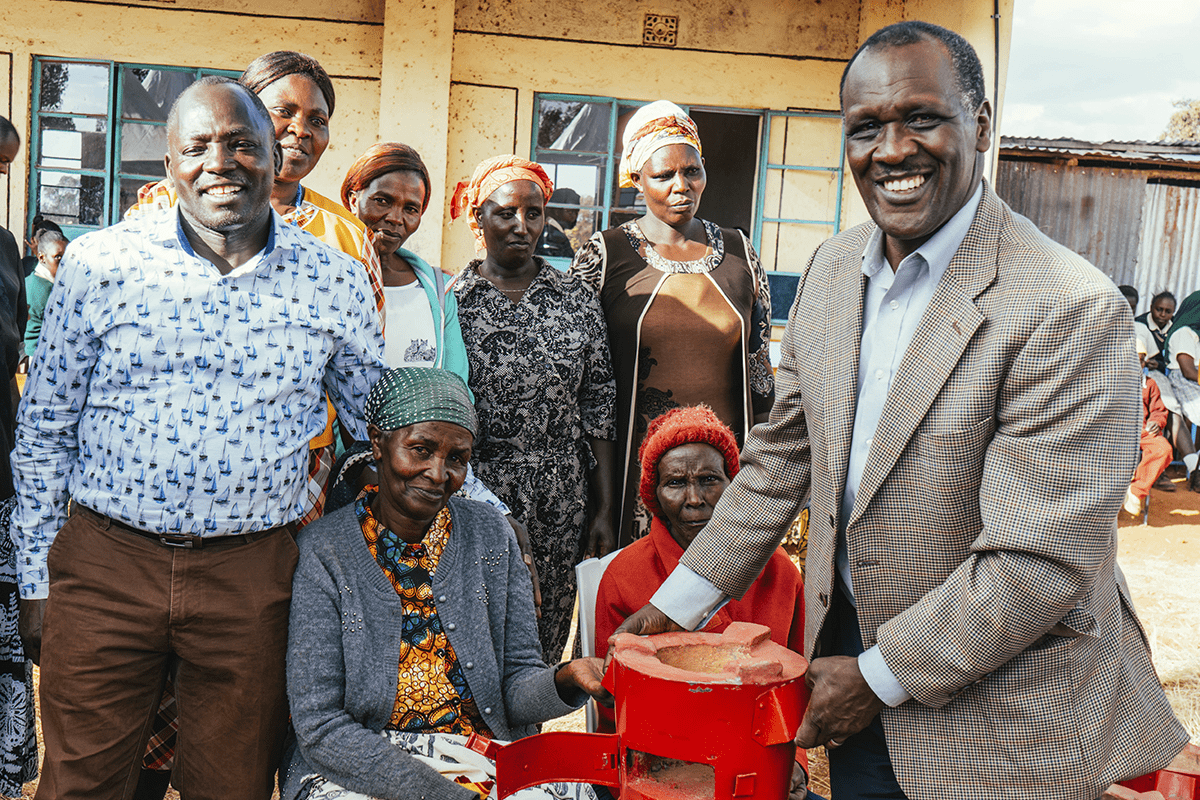
Local people receiving an energy-efficient cookstove - Hongera Energy Efficient Cookstoves Project, Kenya, Green Earth.
Read more about our vision here
The three pillars of sustainability
1. Environmental sustainability
Environmental sustainability refers to the ability to maintain the health and productivity of natural ecosystems over the long term. It involves using natural resources in a way that does not degrade the environment or deplete its resources, but instead ensures these resources are available for future generations.
Environmental sustainability is based on the principle that we should use natural resources at a rate that allows them to naturally regenerate and replenish without causing long-term environmental damage or harm. This involves balancing economic and social needs with preserving ecosystems, biodiversity, and natural resources.
Certain ways we can act on safeguarding environmental sustainability include protecting natural resources and reducing our environmental impact.
Read more: Why is environmental sustainability essential?
The importance of protecting natural resources
Protecting natural resources is essential for environmental sustainability and our wellbeing as a society. Natural resources provide us with the food we eat, the water we drink, and the air we breathe. They also support economic activities such as agriculture, mining, and forestry. However, natural resources are finite. If we continue to deplete them at an unsustainable rate, we risk damaging the ecosystems that support life on our planet.
By protecting natural resources and sustainably using them, we can ensure they will be there for future generations too. Moreover, protecting natural resources can help mitigate the impacts of changing environmental conditions, improve air and water quality, and enhance biodiversity. Overall, protecting natural resources is vital for promoting environmental sustainability and ensuring the long-term health and wellbeing of our planet and its inhabitants.
Read more: Why we need to restore high-priority areas like Africa
At Green Earth, our projects are based on a long-term vision: making an impact that will continuously benefit generations to come.
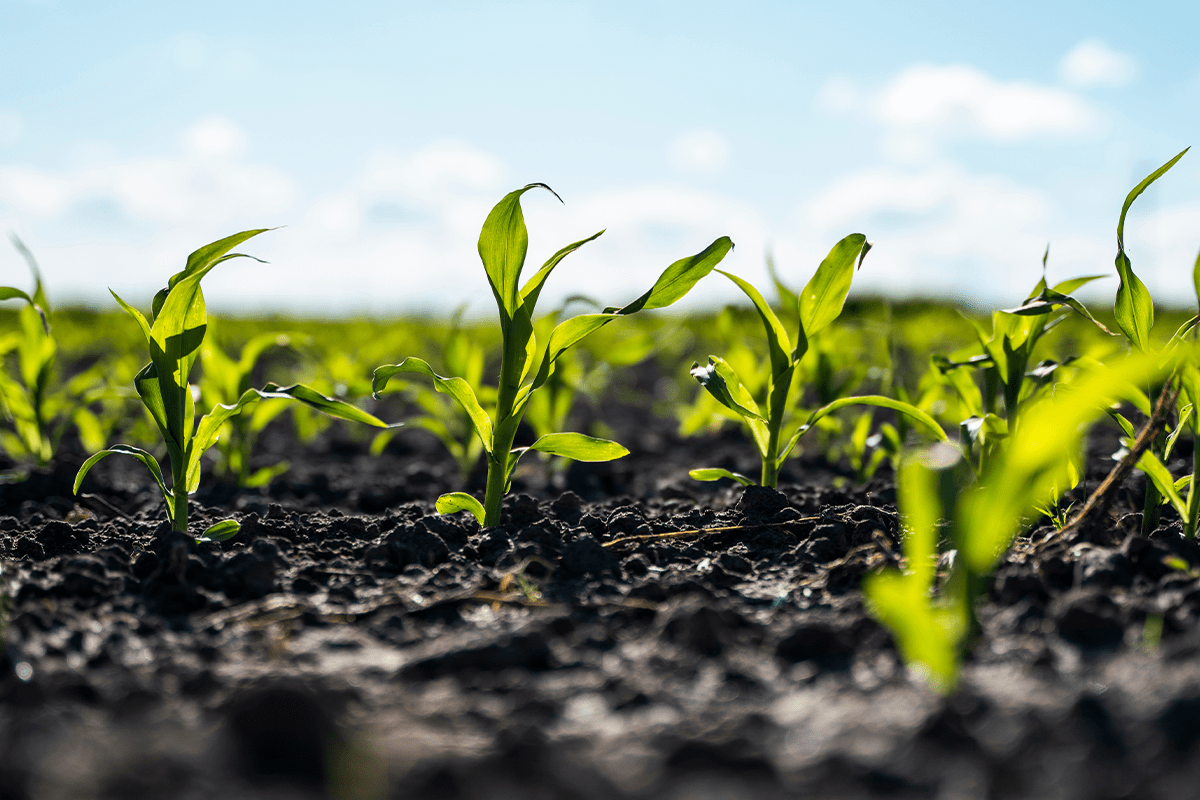
Young, green corn seedling, agricultural farm field.
How to reduce environmental impact
Renewable energy
Renewable-energy sources such as solar, wind, and hydropower are essential for reducing our environmental impact. Unlike fossil fuels, which are finite and non-renewable, renewable energy sources are abundant, clean, and have a lower carbon footprint. By shifting towards renewable energy, we can reduce our dependence on fossil fuels, enhance energy security, and stimulate economic growth in certain areas.
Read more about the past and the future of renewable energy
Sustainable agriculture
Sustainable agriculture is an essential component of environmental sustainability. It involves using farming practices that protect soil health, reduce water usage, and minimise the use of pesticides and fertilisers. Sustainable agriculture also promotes biodiversity, preserves natural resources, and reduces carbon emissions.
Read more: Dry farming: growing crops without irrigation
By adopting sustainable agricultural practices, we can produce food in an environmentally responsible, socially equitable, and economically viable way. Sustainable agriculture also helps promote food security, enhance rural development, and improve the health and wellbeing of farmers and communities.
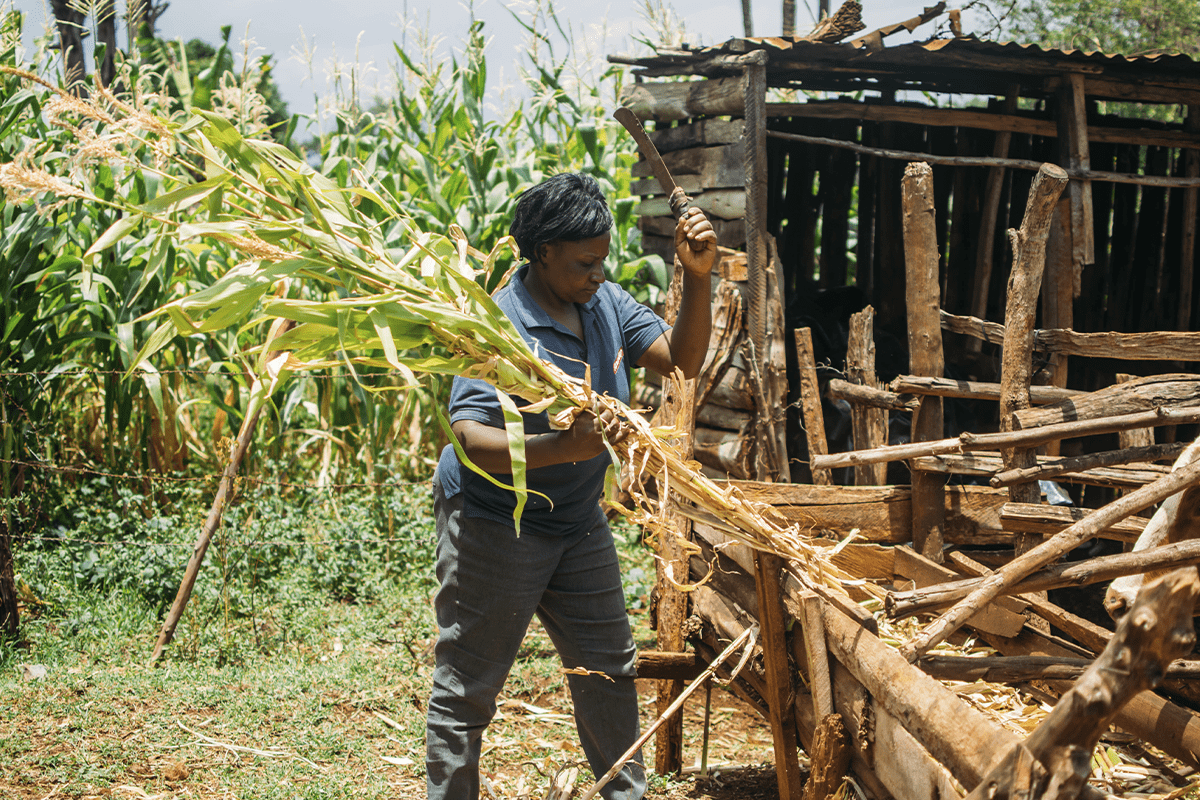
Local woman harvesting wheat - Hongera Energy Efficient Cookstoves Project, Kenya, Green Earth.
Waste reduction and recycling
Waste reduction and recycling are crucial for reducing our environmental impact. By reducing waste, we minimise the resources we use, reduce pollution, and conserve energy. Recycling also reduces the amount of waste that goes to landfills, which can help reduce carbon emissions and promote environmental sustainability.
By adopting waste reduction and recycling practices, we can reduce our environmental impact, conserve natural resources, and promote a circular economy where waste is minimised and resources are reused and recycled.
2. Economic sustainability
Economic sustainability refers to the ability of an economy to maintain its productivity and growth over the long term while ensuring its resources are used responsibly and efficiently. Economic sustainability involves balancing economic growth with environmental and social concerns. It requires the use of resources and the production of goods and services in a way that does not compromise the ability of future generations to thrive and prosper.
Economic sustainability also entails creating inclusive, equitable, and socially responsible opportunities for economic growth and prosperity. This can include investing in education, infrastructure, and research and development, as well as promoting entrepreneurship, innovation, and responsible business practices. Overall, economic sustainability is meant to create a resilient and dynamic economy that benefits everyone, now and in the future.
Certain strategies to ensure economic sustainability include creating a stable economy, promoting socially responsible investing, supporting local businesses, and ensuring fair wages.
Read more: Overcoming sustainability challenges: practical solutions for your business
The importance of creating a stable economy
Creating a stable economy is crucial for promoting long-term sustainable development and ensuring the wellbeing of individuals and communities. A stable economy can provide job security, income stability, and access to resources and opportunities, which are essential for improving individuals' and communities' quality of life. Stable economies also encourage investment, innovation, and entrepreneurship, which can create new businesses, jobs, and products.
Additionally, stable economies can provide a foundation for addressing environmental and social challenges, as they provide resources and infrastructure for implementing sustainable solutions. Green Earth believes that a stable economy is essential for creating a sustainable future that promotes the wellbeing of people and the planet. This is why our projects are designed to support and empower local communities and ecosystems.
Read more: The power of Green Earth Group’s high-quality carbon projects in Kenya
How to promote economic sustainability
Socially responsible investing
Socially responsible investing (SRI) is an investment strategy that considers environmental, social, and governance (ESG) factors in addition to financial returns. SRI allows investors to support socially and environmentally responsible companies while generating profits.
By investing in companies that positively impact society and the environment, SRI promotes economic sustainability by encouraging responsible business practices—such as carbon project financing—and creating economic opportunities that benefit both people and the planet.
To support our projects, interested parties are invited to learn more about our green bonds. They carry an 8% return on investment and are directed towards supporting the implementation and scaling of our nature-based solutions.
Support for local businesses
Supporting local businesses is an essential component of economic sustainability. Such businesses often employ local workers and source their materials and supplies locally, helping to support the local economy and creating jobs. By supporting local businesses, we can reduce transportation-related emissions and create opportunities for entrepreneurship and innovation. Additionally, supporting local businesses can help build stronger communities, enhance social cohesion, and promote a sense of ownership and pride in the local economy.
Fair labour practices
Fair labour practices involve not only fair wages, but also safe working conditions and dignified and respectful treatment. By promoting fair labour practices, we create more inclusive and equitable economies that benefit workers, businesses, and society as a whole. Fair labour practices can also help reduce the risk of social unrest, improve productivity, and enhance the reputation and competitiveness of businesses. Overall, fair labour practices are essential for creating a sustainable economy that benefits everyone, now and in the future.
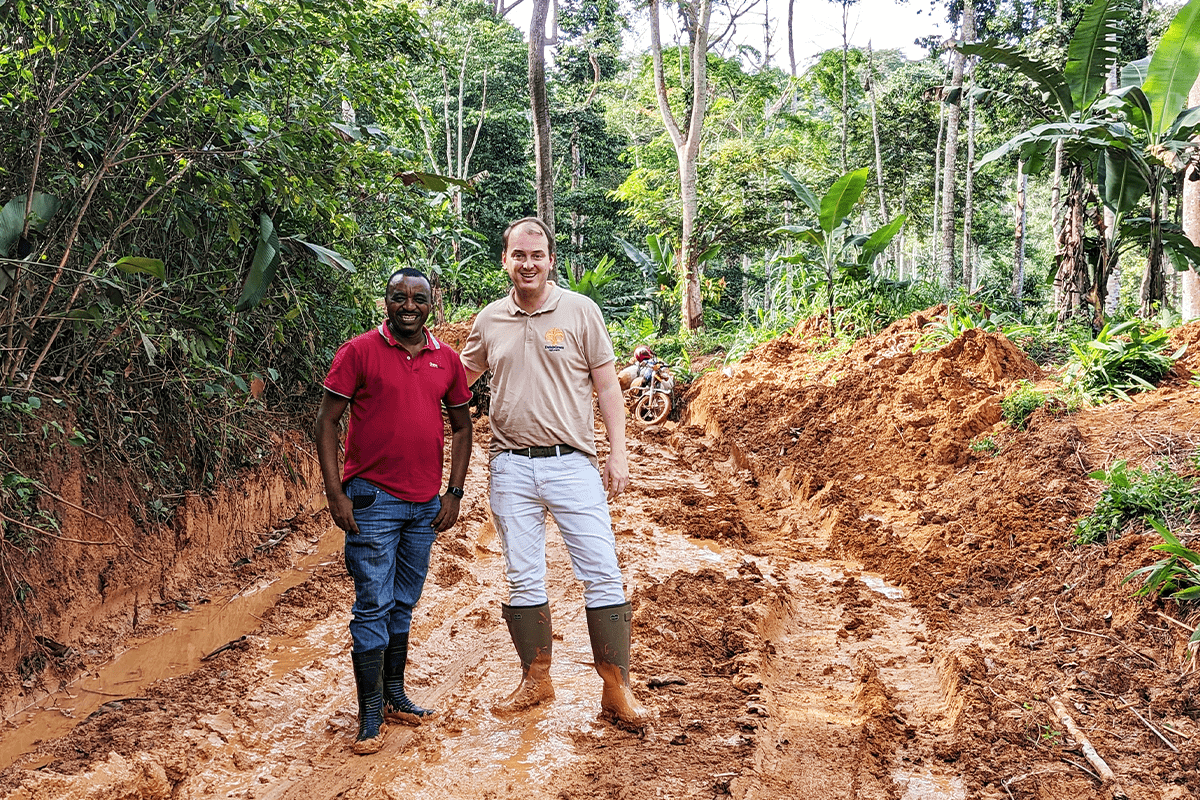
Theo Oben with CEO Selwyn Duijvestijn on newly dug roads - Greenzone Afforestation Project, Cameroon, Green Earth.
Read more about how tree planting can boost employee engagement
3. Social sustainability
Social sustainability refers to the ability of a society to meet the needs of its members while maintaining social cohesion, equity, and diversity over the long term. It involves ensuring that everyone has access to basic human rights, including healthcare, education, and employment, but also that their cultural and social needs are met. Social sustainability also involves promoting social justice, equality, and human dignity, as well as preserving cultural heritage and diversity. Social sustainability aims to create a just, equitable, and inclusive society where everyone can thrive and reach their full potential, now and in the future.
Methods supporting the application of social sustainability in day-to-day life are based on promoting social justice and equality, supporting community engagement, universal access to education and healthcare, and celebrating diversity through inclusion.
The significance of promoting social justice and equality
Promoting social justice and equality is essential for achieving social sustainability. When we promote social justice and equality, we ensure everyone has equal access to basic human rights, including healthcare, education, and employment, regardless of race, gender, ethnicity, or social class. Additionally, promoting social justice and equality helps reduce social inequalities, such as poverty and exclusion, which can lead to social unrest, political instability, and economic inefficiency.
Read more: What makes Green Earth’s reforestation projects unique?
How to promote social sustainability
Community engagement
Community involvement and engagement are essential for promoting social sustainability. By involving community members in decision-making processes, we can ensure their needs and concerns are addressed and policies and programmes are designed to meet their needs. Additionally, community involvement and engagement help build social cohesion, promote solidarity, and create a sense of ownership and pride in the community. All these can lead to increased social capital, improved wellbeing, and a more sustainable and resilient society.
Access to education and healthcare
Access to education and healthcare is critical for promoting social sustainability. Education provides individuals with the knowledge, skills, and opportunities to participate fully in society, achieve their goals, and contribute to the community. Healthcare ensures everyone has access to essential medical care, regardless of their ability to pay. This can help to reduce health inequalities and improve overall well-being. By promoting access to education and healthcare, we can create a more inclusive and equitable society where everyone has the opportunity to thrive.

Local engagement - Hongera Energy Efficient Cookstoves Project, Kenya, Green Earth.
Diversity and inclusion
Diversity and inclusion are essential for promoting social sustainability. By embracing diversity, we recognise and respect the differences within our society, including differences in culture, language, religion, and ethnicity. Promoting inclusion ensures everyone feels valued and included, regardless of background or identity. This helps to reduce social exclusion, discrimination, and prejudice and creates a more cohesive and harmonious society. Additionally, diversity and inclusion promote creativity and innovation by bringing together different perspectives and experiences to solve complex problems and create new opportunities.
Read more: The 3 pillars of corporate sustainability
Integrate trees into your business
We can help your company become more sustainable by integrating trees into your business.
Sustainable practices in different industries
Sustainable practices in agriculture and food systems
Sustainable practices in agriculture and food systems involve using practices that promote environmental, economic, and social sustainability in the production and distribution of food. This includes conservation agriculture, integrated pest management, precision agriculture, agroforestry, sustainable livestock management, sustainable fisheries, and local and regional food systems. By adopting these sustainable practices, we ensure our food production and consumption are sustainable, equitable, and resilient.
Why is sustainable agriculture important?
Sustainable agriculture is essential for promoting environmental, economic, and social sustainability. It uses farming practices that protect the environment, conserve natural resources, and promote the health and wellbeing of farmers and communities. Sustainable agriculture helps reduce agriculture’s negative environmental impact, such as soil erosion, water pollution, and carbon emissions, while promoting biodiversity and ecosystem services.
Additionally, sustainable agriculture increases productivity and profitability for farmers, while ensuring they have access to markets and meet the changing demands of consumers. Finally, sustainable agriculture improves the health and wellbeing of communities by providing access to healthy and nutritious food, promoting food security, and supporting local economies. Overall, sustainable agriculture is essential for creating a more sustainable and resilient food system that benefits everyone.
How to promote sustainable agriculture
Organic farming
Organic farming is a sustainable-farming practice that uses natural inputs and processes to produce crops and livestock. Organic farming avoids synthetic pesticides, fertilisers, and genetically modified organisms (GMOs), instead focusing on building healthy soil, promoting biodiversity, and conserving natural resources. Organic farming helps reduce agriculture’s negative environmental impact, such as soil erosion, water pollution, and carbon emissions, while promoting animal welfare and human health. Additionally, organic farming can be more profitable, as organic products often command a higher price in the market and can provide access to new markets and consumers.
Regenerative agriculture
Regenerative agriculture is a holistic farming approach that focuses on rebuilding soil health, promoting biodiversity, and enhancing ecosystem services. Regenerative agriculture involves practices such as crop rotation, cover cropping, no-till farming, and the integration of livestock into cropping systems. These practices help capture soil carbon, reduce erosion, and promote biodiversity. Regenerative agriculture can also improve the resilience of farming systems by increasing water-holding capacity and improving soil fertility. Additionally, regenerative agriculture can improve farming operations' profitability and economic sustainability by reducing input costs and increasing yields.
Agroforestry
Agroforestry is a sustainable land-use system combining trees with crops or livestock. Agroforestry systems provide a range of ecosystem services, such as soil conservation, carbon sequestration, biodiversity conservation, and water management. Agroforestry can also improve the productivity and profitability of farming systems by providing additional sources of income, such as timber, fruits, nuts, and other non-timber forest products. Additionally, agroforestry can improve the resilience of farming systems to changing environmental conditions, reducing the impact of extreme weather events, such as droughts and floods, and providing shade and shelter to crops and livestock.
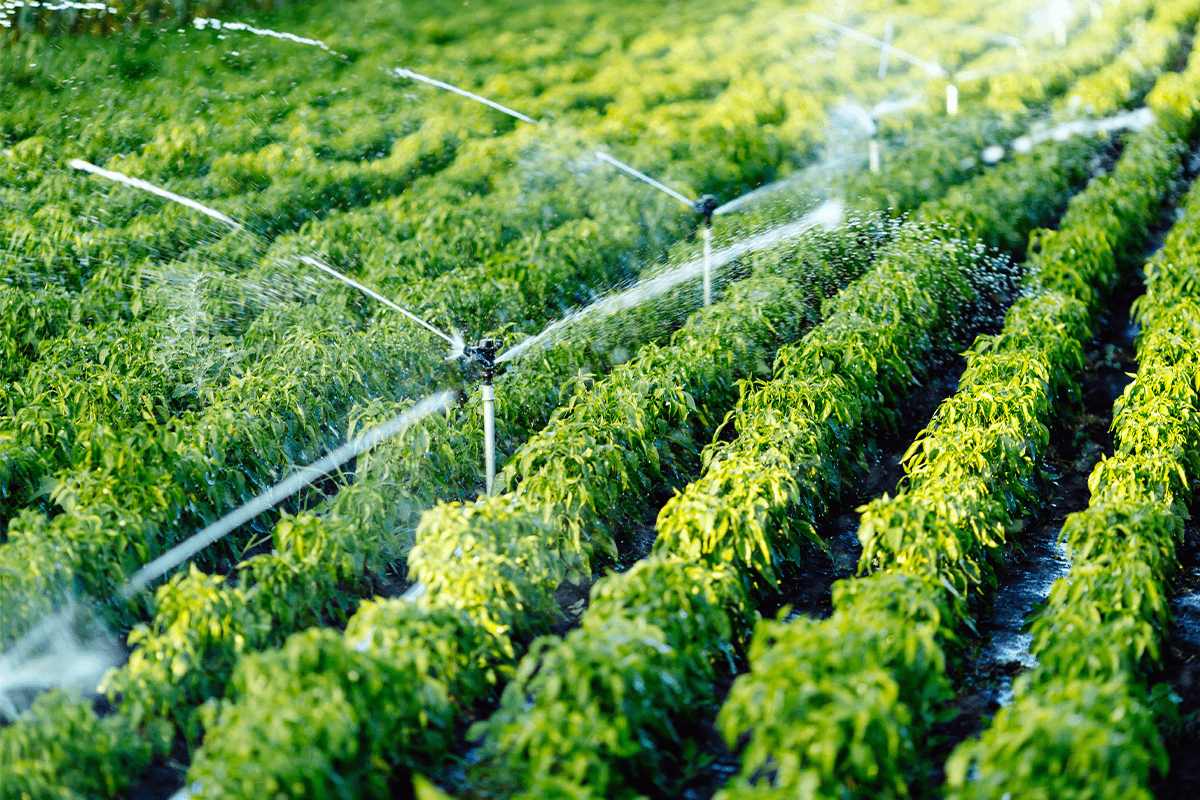
Irrigation system watering plants.
Read more: Benin's agroforestry efforts to combat deforestation
Sustainable practices in transportation
Sustainable practices in transportation involve using practices that promote environmental, economic, and social sustainability in the movement of goods and people. It includes using alternative fuel and efficient vehicles, promoting public and active transportation, implementing transportation demand management, and designing sustainable infrastructure. By adopting these sustainable practices, we can reduce our environmental impact, save money, and promote social equity and mobility.
Read more: How to reduce your business’ travel emissions through nature
The importance of reducing emissions
Reducing emissions in transportation is key because the transportation sector is a significant contributor to carbon emissions, which are a major driver of changing environmental conditions. By reducing emissions in transportation, we reduce the frequency of extreme weather events, rising sea levels, and ecosystem disruptions. Additionally, reducing transportation emissions improves air quality and public health, as emissions from transportation lead to respiratory problems and other health issues. Finally, reducing transportation emissions leads to cost savings, as it reduces fuel costs and improves the efficiency of transportation systems.
How to promote sustainable transportation
Electric vehicles
Electric vehicles (EVs) are an important way to promote sustainable transportation. They emit fewer carbon emissions and other pollutants than traditional gasoline-powered vehicles, which helps reduce transportation's impact on the environment and public health. Additionally, EVs save drivers money on fuel costs and maintenance, as they have fewer moving parts than gasoline-powered vehicles. Some governments and businesses are actively promoting EV use by offering incentives for their purchase, installing charging infrastructure, and promoting public awareness about their benefits.
Public transportation
Public transportation, like buses, trains, and subways, is an important way to promote sustainable transportation. Promoting public transportation reduces the number of cars on the road, reducing traffic congestion, carbon emissions, and air pollution. Public transportation can also be more cost-effective than driving, particularly in dense urban areas. Governments and businesses can promote public transportation by investing in infrastructure, providing subsidies, and improving access and convenience.
Active transportation
Active transportation means walking and cycling. By promoting active transportation, we reduce reliance on cars and other motorised transportation, reducing carbon emissions and improving public health. Additionally, active transportation can be a cost-effective and enjoyable way to travel.
Sustainable practices in construction and buildings
Sustainable practices in construction and buildings involve using techniques and materials that promote environmental, economic, and social sustainability in the built environment. It includes using sustainable materials, such as recycled and locally sourced materials, improving energy efficiency through design and insulation, using renewable-energy sources, such as solar power, and implementing water conservation and management strategies.
Read more: The carbon-neutral future of commercial real estate
Sustainable construction practices also promote social equity by providing safe, healthy, and affordable housing and workspaces. By adopting sustainable practices in construction and buildings, we reduce our environmental impact, lower energy costs, improve public health, and promote social equity and sustainability.
Why we should reduce our energy consumption
Energy production significantly contributes to carbon emissions. Reducing our energy consumption can lower our carbon footprint and decrease our environmental impact. Additionally, reducing energy consumption lowers energy costs and improves energy security by reducing our reliance on non-renewable energy sources such as oil and gas. Simple actions like turning off lights and electronics when not in use, using energy-efficient appliances and vehicles, and improving building insulation can reduce energy consumption and promote sustainability.
How to promote sustainable construction and buildings
Green building materials
Green building materials are an essential part of sustainable construction and buildings. These materials are environmentally friendly and sustainable throughout their lifecycle, from production to disposal. They can include materials made from recycled content, sustainably harvested wood, and low-impact manufacturing processes. Using green building materials reduces our environmental impact and promotes sustainability in the built environment.
Energy-efficient design
Energy-efficient design is another critical component of sustainable construction and buildings. It involves designing buildings using less energy through improved insulation, natural ventilation, and efficient lighting systems. By designing buildings to be energy-efficient, we reduce energy consumption and associated costs while promoting environmental sustainability.
Sustainable landscaping
Sustainable landscaping is also an important way to promote sustainability in the built environment. It involves using plants and landscaping strategies requiring less water and maintenance and promoting biodiversity. Sustainable landscaping can also help reduce urban heat island effects and improve air quality, leading to a healthier and more sustainable environment.
Read more: Green infrastructure: how nature can improve urban living
Challenges to sustainability
Environmental instability
Environmental instability refers to unpredictable and extreme changes in environmental and climate patterns. These changes include more frequent and severe weather events like droughts, floods, heat waves, and hurricanes. Environmental instability can also lead to changes in ecosystems and habitats, putting many plant and animal species at risk of extinction. The increasing frequency and intensity of environmental instability events pose significant challenges to human societies, as they can cause significant economic and social disruption, displacement, and loss of life. Addressing environmental instability requires urgent and coordinated action to reduce carbon emissions and promote sustainability in all aspects of society.
Addressing environmental instability
Addressing environmental instability is crucial for several reasons. Firstly, extreme weather events and other impacts of environmental instability pose significant risks to human societies, including damage to infrastructure, loss of life, and economic disruption. Secondly, environmental instability puts many plant and animal species at risk of extinction, leading to significant biodiversity loss. Thirdly, environmental instability is linked to increasing carbon emissions, which contribute to changing environmental conditions. Without addressing environmental instability, we risk irreversible damage to the planet and the systems that support life on Earth. Finally, addressing environmental instability provides an opportunity to create a more sustainable and equitable future for all, promoting innovation, economic growth, and social progress that benefits current and future generations.
Read more: The Science Based Targets initiative and carbon offsetting: striking the right balance
How to reduce carbon emissions
There are several ways to reduce carbon emissions. They all require concerted action at individual, community, and global levels. The most effective ways to reduce carbon emissions include shifting to renewable-energy sources, such as solar, wind, and geothermal power; promoting energy efficiency through measures like building insulation and energy-efficient appliances; improving public transportation systems; reducing reliance on personal vehicles; and adopting sustainable practices in agriculture, forestry, and land use.
Read more: Overcoming sustainability challenges: practical solutions for your business
Additionally, individuals and organisations can reduce their carbon footprints by minimising waste, reducing water usage, and supporting policies prioritising sustainability and conservation. Collectively, these efforts can significantly reduce carbon emissions and create a more sustainable future for all.
Read more: SME sustainability tools: How they help your business grow
Biodiversity loss
Biodiversity loss refers to the decline in the variety and abundance of plant and animal species in a given ecosystem or across the planet. This loss is often caused by human activities such as deforestation, pollution, and overfishing. It can significantly affect ecosystem functioning, human health, and the planet's overall health.
 African elephant roaming the bushveld.
African elephant roaming the bushveld.
Preserving biodiversity
Preserving biodiversity is the foundation of healthy ecosystems and their services, such as clean air and water, nutrient cycling, and pollination. Biodiversity also has direct and indirect economic value, providing resources for food, medicine, and other products and supporting industries such as tourism and recreation. Moreover, biodiversity has intrinsic value as a source of beauty, wonder, and inspiration.
It is a key component of cultural and spiritual identity for many people and communities around the world. Preserving biodiversity is therefore vital for maintaining the health and wellbeing of the planet and all its inhabitants, present and future.
Read more: The importance of trees in water conservation
How to protect and restore ecosystems
Protecting and restoring ecosystems is essential for preserving biodiversity, mitigating changing environmental conditions, and ensuring the wellbeing of human societies. One way to protect ecosystems is through conservation efforts, such as establishing protected areas, restoring degraded habitats, and reducing threats from invasive species, pollution, and overexploitation.
Read more: How biodiversity loss impacts ecosystems and what we can do to help
Another way is to promote sustainable land-use practices, such as agroforestry, organic farming, and sustainable forestry, that maintain or enhance ecosystem services while supporting human livelihoods. Restoring degraded ecosystems is also important, as it helps reverse the impacts of past damage and enhances the resilience of ecosystems to future change. Restoration can include reforestation, wetland restoration, and coral reef restoration, among others.

Thale Noi wetland, Thailand.
Overall, protecting and restoring ecosystems requires a holistic and integrated approach that recognises the interconnectedness of ecological, social, and economic systems and the importance of long-term planning and collaboration among stakeholders. Green Earth’s projects consider all the factors contributing to paving the way for more sustainable living, keeping communities and ecosystems in balance.
You can take part in this change too: start planting trees with Green Earth
Overconsumption and waste
Overconsumption refers to the excessive consumption of resources beyond what is necessary or sustainable, leading to environmental degradation and social inequalities. Waste , on the other hand, refers to the inefficient use of resources resulting in the production of materials that are discarded or not effectively reused, leading to further environmental problems and economic losses.
Reducing waste and consumption
Reducing waste and consumption is crucial for achieving sustainability and addressing environmental problems such as pollution, rising emissions, and depletion of natural resources. Overconsumption and waste are major contributors to these problems, producing carbon emissions and toxic waste and depleting natural resources such as water and land.
Reducing waste and consumption can be achieved through various measures, such as adopting circular economy principles, reducing packaging and single-use products, and promoting sustainable consumption patterns. By reducing waste and consumption, we can reduce our environmental impact, conserve resources, and contribute to a more sustainable future.
How to promote a circular economy
A circular economy is an economic model seeking to create a closed-loop system in which materials are used and reused indefinitely, minimising waste and environmental impact. It is based on the principles of reduction, reusing, and recycling and aims to design out waste and pollution, keep products and materials in use, and regenerate natural systems.
Read more: Net zero and a circular economy: Top 3 opportunities and challenges
One way to promote a circular economy is through sustainable product design, which involves designing products that are easy to repair, upgrade, and recycle. Another way is through the adoption of extended producer responsibility programmes, which hold producers responsible for the entire lifecycle of their products and incentivise them to design more sustainably. Additionally, promoting circular business models, such as product-as-a-service, can encourage more sustainable consumption patterns and reduce waste. Promoting a circular economy can reduce waste, conserve resources, and create a more sustainable and resilient economy.
Read more: The roots of a sustainable future: integrating trees into a circular economy

Clothing from recycled materials.
Green Earth values the importance of sustainability for a better tomorrow
Sustainability is vital for a better tomorrow. Our mission at Green Earth is to help nature prosper and flourish—this can only become a reality if we implement sustainable strategies in all sectors of human activity. The result is that not only nature will thrive, but also us as a society. We must prioritise the health of our planet, society, and economy to ensure we create a livable and equitable future for all life forms.
Addressing environmental instability, protecting and restoring ecosystems, reducing waste and consumption, and promoting sustainable practices in agriculture, transportation, construction, and buildings are all essential steps towards achieving sustainability. Only together, can we create a sustainable future that benefits current and future generations by reducing our environmental impact, promoting economic stability, and fostering social justice and equality. It is essential to act now and take responsibility for our actions to secure a better tomorrow for all.
Let us inform you
We will keep you updated on all the latest news.










 African elephant roaming the bushveld.
African elephant roaming the bushveld.
